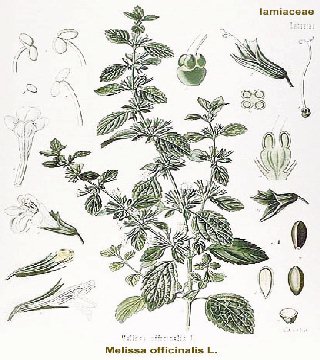
Melissa
The Natural Medicine for Herpes
Allison Solomon and Jennifer Baker

Origin of Names: Lemon balm, sweet balm, honey plant, balm mint, blue balm, and bee-balm. Belongs to the "mint" family of Lamiaceae.
Description of Plant: Melissa grows from one to two feet in height. It displays white and yellow flowers and bright, green leaves that emit a lemon smell. Melissa grows best in areas that are rich in both shady and moist soil.
World Region: Melissa is native to Southern Europe and is commonly seen growing in many European gardens. It is also cultivated in other areas including the eastern USA, Latin America, and West Indies. The climate needs to be fairly cool for the optimal growing conditions.
Part Harvested: The part of the Melissa plant that is usually harvested is the aromatic leaves. It contains the active components of Melissa as well as essential oils such as peppermint and thyme.
Medicinal Effects: The main active component in Melissa is caffeic acid. It contains other components including protocatechuic acid, rosmarinic acid, and two flavonoids, luteolin 7-glycoside and rhamnazin II. Melissa exhibits antispasmodic, antimicrobial, antioxidative, carminative, sedative, and antiviral properties.
History/Folk Use: The use of Melissa dates back to ancient time when the Europeans prescribed it for longevity, memory, fertility, and as an aid to beekeepers. The first published mention of Melissa appeared around 300 BC in Historia Plantarium. This was a book compiled by Theophrastus of Ephesus, who was a pupil of Aristotle. Between 50 and 80 AD, Plinus Securdus recommended Melissa to be used externally to treat insect bites and internally for the treatment of abdominal colic and uterine spasms. In 810, Charlemagne demanded his people to plant Melissa all around his kingdom. In 1978, it was discovered that the aqueous extract of Melissa demonstrated antiviral effects against both herpes simplex types one and two.
Uses: There are many uses of Melissa. It is most often used as a mild sedative to relieve insomnia and anxiety. It is also used as an antispasmodic to treat intestinal colic and menstrual cramps. Externally, it is applied to wounds as an antimicrobial agent. It is also used as an antiviral agent against herpes simplex virus type 1 and 2 and the varicella zoster virus.
Pharmacology: Even though Melissa is said to exhibit sedative, antimicrobial, antispasmodic, carminative, and antioxidant properties, only the antiviral mechanism of action has been discussed. The mechanism of action of Melissa's antiviral activity is due to caffeic acid. It inhibits the viral protein synthesis by inhibiting the incorporation of [14C] leucine into the proteins. It thus, diminishes the amount of peptidyl-tRNA in the donor sites of the ribosome and inhibits the overall reproduction of the virus.
Drug/Disease Interactions: Melissa may have a thyrotropin-inhibiting effect, therefore, patients with a thyroid condition should first consult a physician. Because of the sedative properties of Melissa, may have a drug interaction with benzodiazepines and other sedative drugs. Should also avoid excessive alcohol.
Toxicity: Melissa is generally recognized as safe. No major toxicity has been noted. Because of sedative effects, may cause drowsiness.
Dosages: Available as a 70:1 extract cream for herpes simplex infections in Germany. The only producer of the cream is Lomapharm in Germany. Melissa is also available as a 2% solution for the treatment of the varicella zoster viral infection. However, Melissa is most often prepared as a "lemon" tea. There are two ways to prepare the tea. Lemon Balm tea bags are available at the grocery store. Take one cup of hot water and allow the tea bag to immerse in the water for five minutes. Also, one can take one and a half tablespoonful of the Melissa leaves and put it in one pint boiling hot water. After boiling, remove from heat and allow to steep 15-20 minutes before straining and drinking.
References
1. Chlabicz J, Galasinski W. "Components of Melissa of ficinalis L. that influence protein biosynthesis in vitro." Journal of Pharmacy & Pharmacology. 38(Nov): 791 -794.1986.
2. de Vries, Jan. "Melissa Extract: The Natural Herbal Remedy for Herpes." Keats Good Health Guide. Keats Publishing, Inc. New Canaan, Connecticut. 1996.
3. Dimitrova Z, Dimov B, Manolova N, Pancheva S, Llieva D, Shishkov S. "Antiherpes effect of Melissa of ficinalis L. extracts." Acta Microbiologica Bulgarica. 29:65-72, 1993.
4. Hener U, Faulhaber S, Kreis P, Mosandle A. "On the authenticity evaluation of balm oil" Pharmazie. 50(Jan): 60-62.1995.
5. Heinerman, John. "Lemon Balm." Healing Herbs and Spices. Prentice Hall, Englewood Cliffs, New Jersey. 1996.
6. Mohrig A., Alken, RG. "Melissa Extract in Comparison to Acyclovir." Pharmazeutische Rundschau. 413/1996.
7. Vaverkova S, Tekel J, Holla M. "The effect of herbicides on the qualitative properties of medicinal plants. Part 3: Content and composition of the essential oil from Melissa of ficinalis L. after application of Basagran." Pharmazie. 50(12): 835-6, 1995 Dec.
Web sites as follows:
http://www.egregore.com/herb/Balm.htm
http://www.crop .cri.nz/broadshe/lemon.htm
http ://www.dreamscape.com/morgana/phobos.htm
